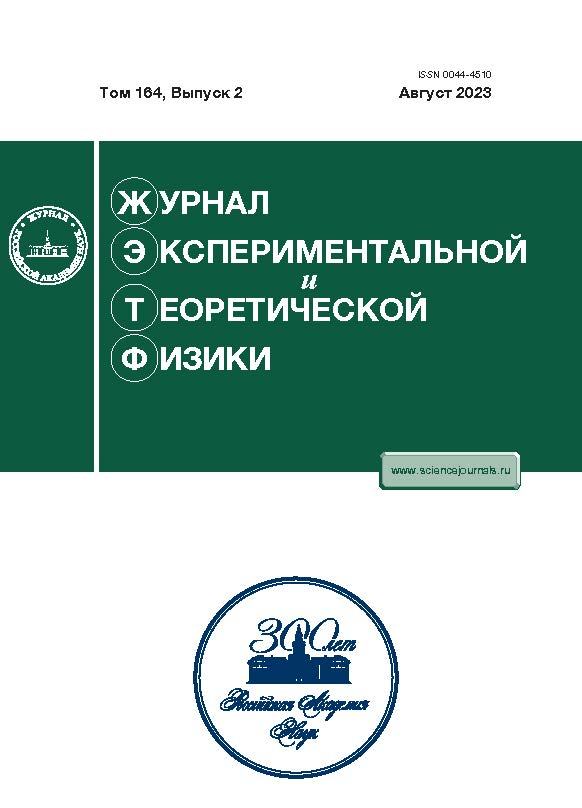Optimization of Feedback-Loop Parameters in Thulium Optical Clocks at Synchronous Comparison
- Authors: Tregubov D.O.1, Provorchenko D.I.1, Mishin D.A.1, Kolachevskiy N.N.1,2, Golovizin A.A.1
-
Affiliations:
- Lebedev Physical Institute, Russian Academy of Sciences
- International Center of Quantum Technologies
- Issue: Vol 164, No 2 (2023)
- Pages: 223-229
- Section: Articles
- URL: https://kld-journal.fedlab.ru/0044-4510/article/view/653670
- DOI: https://doi.org/10.31857/S0044451023080084
- EDN: https://elibrary.ru/IANIDK
- ID: 653670
Cite item
Abstract
Synchronous comparison of optical clocks using phase-coherent clock lasers makes it possible to determine the difference (ratio) of clock transition frequencies, which is not limited by the total noise of lasers in use. A detailed simulation of the comparison of two thulium optical clocks is performed using synchronous interrogation of atoms by the radiation of a common clock laser. Some critical parameters have been determined, specifically: the residual noncorrelated frequency and amplitude noises of test pulses and reading noises, which may deteriorate the comparison stability. At the same time, it is demonstrated that this way is insensitive to fluctuations in the number of atoms, calibration of feedback-loop parameters, individual ejections in measurement cycles, and fluctuations of laboratory magnetic field.
About the authors
D. O. Tregubov
Lebedev Physical Institute, Russian Academy of Sciences
Email: iaushev.mo@phystech.edu
Moscow, 119991 Russia
D. I. Provorchenko
Lebedev Physical Institute, Russian Academy of Sciences
Email: iaushev.mo@phystech.edu
Moscow, 119991 Russia
D. A. Mishin
Lebedev Physical Institute, Russian Academy of Sciences
Email: iaushev.mo@phystech.edu
Moscow, 119991 Russia
N. N. Kolachevskiy
Lebedev Physical Institute, Russian Academy of Sciences;International Center of Quantum Technologies
Email: iaushev.mo@phystech.edu
Moscow, 119991 Russia;Moscow, 121205 Russia
A. A. Golovizin
Lebedev Physical Institute, Russian Academy of Sciences
Author for correspondence.
Email: artem.golovizin@gmail.com
Moscow, 119991 Russia
References
- T. Nicholson, S. Campbell, R. Hutson, G. Marti, B. Bloom, R. McNally, W. Zhang, M. Barrett, M. Safronova, G. Strouse, W. Tew, and J. Ye, Nature Сommun. 6, 1 (2015).
- S. M. Brewer, J. Chen, A. M. Hankin, E. R. Clements, C. W. Chou, D. J. Wineland, D. B. Hume, and D. R. Leibrandt, Phys. Rev. Lett. 123, 033201 (2019).
- N. Huntemann, C. Sanner, B. Lipphardt, C. Tamm, and E. Peik, Phys. Rev. Lett. 116, 063001 (2016).
- T. Bothwell, D. Kedar, E. Oelker, J. M. Robinson, S. L. Bromley, W. L. Tew, J. Ye, and C. J. Kennedy, Metrologia 56, 065004 (2019).
- E. Oelker et al., Nature Photon. 13, 714 (2019).
- T. Bothwell, C. J. Kennedy, A. Aeppli, D. Kedar, J. M. Robinson, E. Oelker, A. Staron, and J. Ye, Nature 602, 420 (2022).
- H. Inaba, K. Hosaka, M. Yasuda, Y. Nakajima, K. Iwakuni, D. Akamatsu, S. Okubo, T. Kohno, A. Onae, and F.-L. Hong, Opt. Express 21, 7891 (2013).
- A. Golovizin, E. Fedorova, D. Tregubov, D. Sukachev, K. Khabarova, V. Sorokin, and N. Kolachevsky, Nature Commun. 10, 1724 (2019).
- A. A. Golovizin, D. O. Tregubov, E. S. Fedorova, D. A. Mishin, D. I. Provorchenko, K. Y. Khabarova, V. N. Sorokin, and N. N. Kolachevsky, Nature Commun. 12, 5171 (2021).
- A. Golovizin, D. Tregubov, E. Fedorova, D. Mishin, D. Provorchenko, D. Sukachev, K. Khabarova, V. Sorokin, and N. Kolachevsky, AIP Conf. Proc. 2241, 020016 (2020).
- A. Golovizin, D. Tregubov, D. Mishin, D. Provorchenko, and N. Kolachevsky, Opt. Express 29, 36734 (2021).
- D. Tregubov, A. Golovizin, D. Provorchenko, D. Mishin, V. Sorokin, K. Khabarova, and N. Kolachevsky, 2021 Joint Conference of the European Frequency and Time Forum and IEEE International Frequency Control Symposium (EFTF/IFCS), 1 (2021).
- K. Kudeyarov, G. Vishnyakova, K. Y. Khabarova, and N. Kolachevsky, Laser Phys. 28, 105103 (2018).
- A. Kuhl, T. Waterholter, S. Koke, G. Grosche, G. Vishnyakova, and R. Holzwarth, 2019 Joint Conference of the IEEE International Frequency Control Symposium and European Frequency and Time Forum (EFTF/IFC), 1 (2019).
Supplementary files











